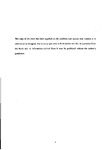Ultrastructure and function of respiratory cilia in critical illness
| dc.contributor.author | Kirkby, Joanne | |
| dc.contributor.other | School of Biomedical Sciences | en_US |
| dc.date.accessioned | 2011-06-28T15:30:24Z | |
| dc.date.available | 2011-06-28T15:30:24Z | |
| dc.date.issued | 2004 | |
| dc.identifier | Not available | en_US |
| dc.identifier.uri | http://hdl.handle.net/10026.1/525 | |
| dc.description.abstract |
Approximately one in eleven hospital patients suffer a nosocomial infection. Intensive care patients are at particular risk and nosocomial pneumonia especially is a problem in the intensive care unit (ICU). The mucociliary transport system is the major defence mechanism against such infection and whilst its efficiency has been shown to be decreased in ICU patients there are few reports in the literature describing the ultrastructure of the respiratory epithelium in this patient group. The principal aims of this study included an investigation of the ultrastructure of the respiratory ciliated epithelium in ICU patients, together with an assessment of the impact of the known risk factors anaesthesia and cigarette smoking on the fine structure and function of the mucociliary transport system Duration of anaesthesia is a risk factor for infection in the ICU and several anaesthetic agents have been shown to impair mucus transport rate (MTR) and ciliary beat frequency (CBF). Rat tissue was used to investigate the effect of the intravenous anaesthetics midazolam and propofol on ciliary survival, whilst the effect of the gas halothane was observed on human cell cultures using high speed digital video recording. There was no deleterious effect of the two intravenous anaesthetic agents on ciliary survival, assessed using a semi-automated image analysis system. However, the damaging effect of halothane was confirmed and associated with novel findings of decreased amplitude and synchrony, as well as cilia beat frequency (decrease of approximately 30%). In contrast to previous reports the study of a large sample of asymptomatic smokers and non-smokers revealed no difference in ciliary abnormalities between the two groups (the proportion of abnormal cilia in each was approximately 3%). The evaluation of ciliary structural abnormalities by transmission electron microscopy confirmed there was wide variation in their occurrence among critically ill patients and that it was imperative, contrary to previous reports, to record a large number of cilia from a range of fields owing to the localised effect of some abnormalities. The present investigation was also the first to make observations on ciliary abnormalities beyond three days admission to the ICU thus providing new information on the ultrastructure of respiratory cilia in long stay ICU patients, potentially leading to improved treatment protocols for this patient group. | |
| dc.language.iso | en | en_US |
| dc.publisher | University of Plymouth | en_US |
| dc.title | Ultrastructure and function of respiratory cilia in critical illness | en_US |
| dc.type | Thesis | |
| dc.identifier.doi | http://dx.doi.org/10.24382/4933 | |
| dc.identifier.doi | http://dx.doi.org/10.24382/4933 |
Files in this item
This item appears in the following Collection(s)
-
01 Research Theses Main Collection
Research Theses Main


